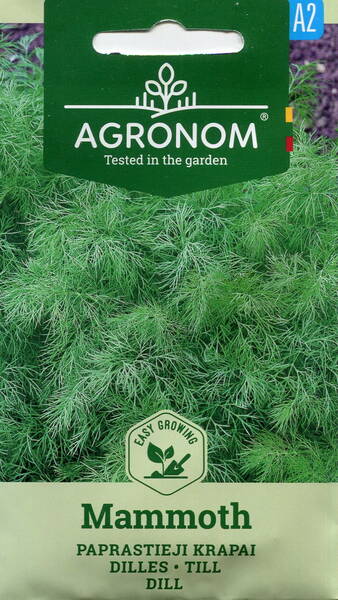Ex Tax: 0.65€
Fragrant, large leaf!
Mid-season variety (from germination to harvesting for greens 38-42 days, for spices - 86 days). The plant is compact, abundantly leafy, and up to 100 cm high in the flowering phase. The rosette of leaves is powerful and semi-raised. The leaves are large, greyish-green with a wax coating, medium dissected up to 20 cm, with high aromaticity and excellent taste. The mass of greens from one plant is 20-30 g. The yield of green mass is 1.8-3 kg/m2.
The value of the variety: stable yield, friendly formation of juicy and delicate greenery, long economic shelf life and high aromaticity.
Recommended for drying, freezing, preparing a variety of seasonings, salting and marinating. Fragrant umbrellas are indispensable in salting and pickling vegetables and mushrooms.
SOWING is done repeatedly - before winter with dry seeds and several times in spring, starting from late April - early May, to a depth of 1-2 cm in a continuous way or in a row (with row spacing of 15-20 cm). To obtain flowering plants, a distance of 45-50 cm is left between the rows. To speed up germination, it is advisable to soak the seeds before sowing for two days, periodically changing the water.
* Growing dill is not difficult, but you need to know some of its features.
This crop likes loose, fertile soil, and does not grow well on compacted heavy soils. Dill suffers especially in lowlands, where water is close to the surface and does not respond well to a lack of air. In such conditions, the plants acquire a characteristic yellow-purple color. After heavy rains, you should not allow a crust to form around the dill plant - it will prevent air from reaching its roots.
When is the best time to sow dill?
It can be sown at different times, you only need to create conditions for seed germination and, above all, provide it with sufficient moisture. Dill can be sown even before winter, in late October - early November. You can also sow it early in the spring, as soon as the snow melts. In this case, the seed consumption is increased to 10 grams per 1 m2. With regular sowing in May and summer, you can sow 5 g of seed per 1 m2, and bush varieties - 2 g per 1 m2. With winter and early spring sowing, it is a good idea to cover the young shoots with covering material, which will save the plants from severe frosts.
Dill can be sown among other crops, but it is better to grow it in a separate bed. For this, the seeds are sown in rows. The distance between the rows is 20-25 cm for ease of weeding and loosening, and in a row between plants 2-3 cm and they are gradually thinned out.
Bush varieties (Alligator, Salute, Amazon) are thinned to 15-20 cm between plants so that they grow as much greenery as possible.
Do I need to soak the seeds?
This method allows you to get quick and friendly shoots, but only on condition that you sow the soaked seeds in moist soil and do not let it dry out before the shoots appear. Otherwise, in dry soil, the hatched seeds will die from lack of moisture.
Soaking the seeds can be done at home 2-3 days before planting. The seeds are placed in a linen bag or old tights can be used for this. The main thing is that water easily penetrates through the material.
The bag with seeds is placed in a container with hot tap water, then, as the water cools, it is changed several times during the day. After this, the next day, the seeds from the bag are poured out onto a damp cloth, dried and sown. Before the shoots appear, the crops are watered and weeded. In the first 2-3 weeks, dill grows slowly and is very oppressed by weeds and thickened shoots. Therefore, the dill bed must be kept free of weeds and thickened plants must be pulled out in time for food.
Dill can be grown in open ground, but if you find a place for it in a film greenhouse, dill will reward you with earlier and more lush greenery.












